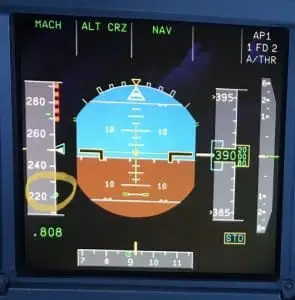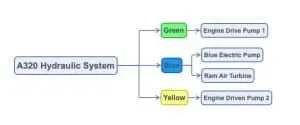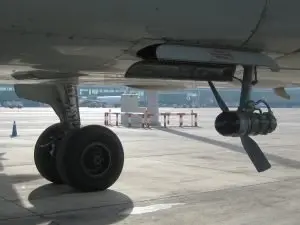
Pete has been flying aircraft for the last 20 years. He has flown everything from light piston aircraft up to heavy jets as both First Officer and Captain. He’s currently enjoying life flying the Airbus A330 for a major international airline.
REC MAX (or “Recommended Maximum”) is calculated by the onboard software and is the maximum altitude currently recommended based on a number of performance factors.
OPT ALT (“Optimum Altitude”) is the optimum altitude based on a number of factors such as Cost Index, weight and weather conditions.
Table of Contents
REC MAX Altitude
There are a number of factors that determine the Recommended Maximum Altitude. On Airbus aircraft REC MAX is the lowest of the following limiting altitudes:
- The altitude that provides a 0.3g buffet margin
- The altitude at which level flight can be maintained at MAX CRZ rating
- The altitude where the aircraft can maintain a vertical speed (climb) of 300 feet per minute at MAX CLB thrust
- The aircraft can fly at a speed greater than Green Dot Speed, and lower that VMO/MMO
- The maximum altitude the aircraft is certified for
Note: the calculation of REC MAX does not take into account the use of engine anti-ice. This correction to REC MAX can be applied by referring to graphs in the Quick Reference Handbook (QRH).
REC MAX computations are made by the FMGES (Flight Management and Guidance Envelope System) and consider the following factors:
- The aircraft’s current gross weight
- OAT (Outside Air Temperature)
- Assumes anti-ice is off

Related: Turbulence Causes and Pilot Mitigation
EO REC MAX Altitude
Engine-out maximum altitude (EO REC MAX) is computed by the FMGES in the event of an engine failure on dual engine Airbus aircraft.
EO MAX ALT is displayed for the Airbus A340 in the event of the loss of two engines.
It is available to the pilots and displayed to them on the PROG page of the MCDU (Multipurpose Control and Display Unit).
EO MAX ALT is based on the maximum altitude that the aircraft can maintain with a failed engine while travelling at long range cruise speed (LRC speed).
E.O. CLR (Engine Out Clear)
If an engine failure is detected by the aircraft the system will automatically display the performance (PERF) page on the MCDU. This page takes into account aircraft performance based on the engine failure.
The E.O. CLR (Engine Out Clear) prompt is displayed on the top right of the PERF page. If one of the pilots selects this prompt, the performance and predictions in the MCDU will revert to the all-engines-operative performance. Its not possible to revert to the engine out performance (unless the aircraft detects another engine failure condition).
The E.O. CLR function allows the pilots to restore all engine operative performance in the event the systems detection of an engine failure is incorrect, or “spurious”.
The pilot should not press the E.O. CLR key if an actual engine-out is detected
Airbus A330/A340 FCOM
Engine Failure Above EO REC MAX
In the event of an engine failure above EO REC MAX, the climb mode (if engaged) will revert to “Open Climb” (OP CLB) and “LVR MCT” (Maximum Continuous Thrust) will last on the FMA (Flight Mode Annunciator).
The pilots will select Max Continuous Thrust by moving the thrust levers to the MCT detent and they will begin a drift down to at or below the EO REC MAX altitude at Green Dot Speed.
Related: A Guide to Airbus Green Dot Speed
the exact conditions limiting the altitude where a subsonic aircraft can safely fly at, these can range from aerodynamic limitations to propulsion and certification limitations.
Airbus – “Control Your Speed in Cruise”
OPT ALT Optimum Altitude
Optimum (and maximum) altitudes are also available in a paper version in the Quick Reference Handbook (QRH). The altitudes are extracted from graphs that give the correct answer depending on the aircraft speed and outside air temperature (OAT).
The results are then corrected if anti ice is needed. The use of anti ice reduces the available thrust from the engines and therefore generally reduces the maximum and optimum altitudes.
Related: The Quick Reference Handbook (QRH) Explained
Step Climbs
Generally, during a flight the optimum altitude will increase as the fuel is burnt off and weight is reduced.
The technique of planning a number of climbs during the flight to take advantage of cost savings due to the change of optimum altitude are known as “step climbs”.
The flight plan (OFP – Operational Flight Plan) supplied to the crew can be configured to show the best altitudes to use during a flight, or the FMS (Flight Management System) can do the same when the crew enter the forecast enroute winds and temperatures.
The Optimum Altitude ensures sufficient buffet margin (stall margin)in turbulence but in the case of severe turbulence Airbus recommends considering a descent to a lower level.
Related: Turbulence and Buffet Margin
FAQ Summary
Why is FL398 sometimes displayed as the REC MAX ALT?
This altitude is the maximum operating altitude at which it is possible for the aircraft to maintain a cabin pressure altitude below 8000 ft.
Further Reading: Airbus Safety First Issue 21
If you found this article interesting please take 5 seconds to share this on your favorite social media. Thanks so much, I really appreciate it! [email protected]

Pete has been flying aircraft for the last 20 years. He has flown everything from light piston aircraft up to heavy jets as both First Officer and Captain. He’s currently enjoying life flying the Airbus A330 for a major international airline.






